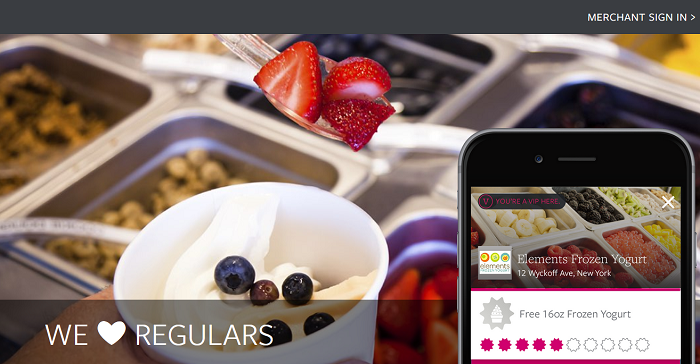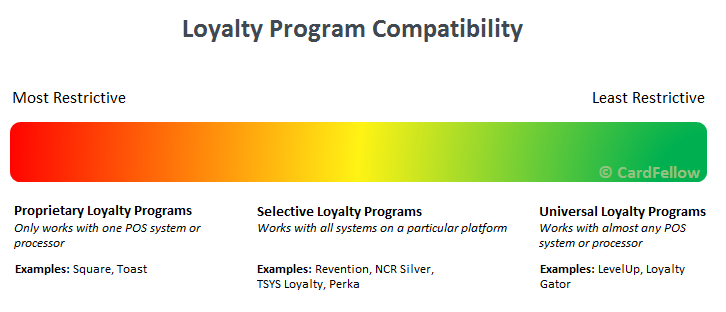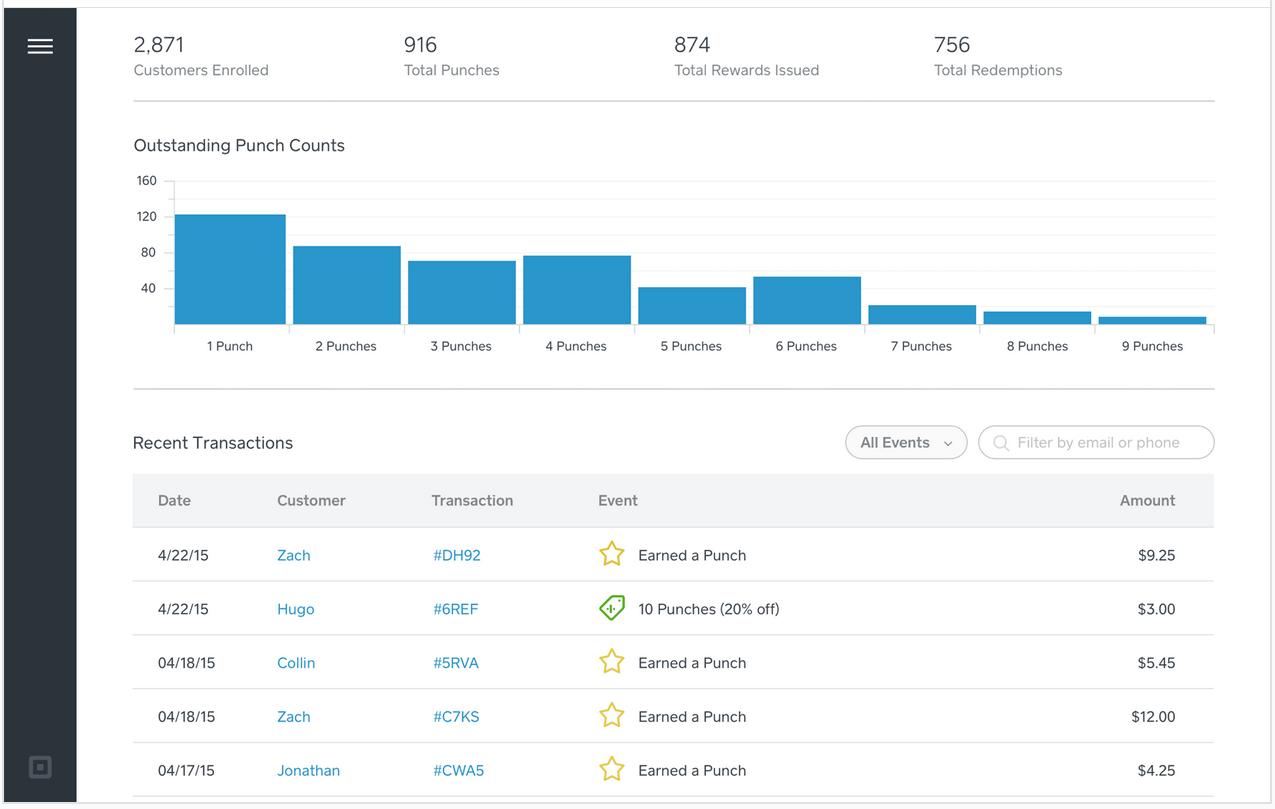You don’t need to be told what a customer loyalty program is – from frequent flier miles to buy-5-get-1-free coffee deals, these programs drive value-savvy customers into businesses and create long-term benefits in the form of returning customers.
What you might not know is how to start a loyalty program, or if it’s really necessary for your business. We’ll tackle all of that in this guide, giving you insight into loyalty and rewards to help you choose the right fit for your business without breaking the bank.
- The Case for Loyalty Programs
- Common Loyalty Programs
- Other Types of Loyalty Programs
- Implementing Loyalty Programs
The Case for Loyalty Programs
According to Hubspot, customer acquisition costs are up to 10x higher than marketing to existing ones. Loyalty programs can keep your current customers engaged and earn repeat business for your store or restaurant. And that’s just one piece of the big picture. Think of how much valuable customer data you’re missing out on that can help you better serve them and grow your business.
Every time a customer swipes a loyalty card or makes a purchase you can track through a POS system, you’re able to pair shopping habits with demographics to gain deeper insight into what attracts them to you. Even just paper punch cards can offer insight – put a date on the card when you first give it to your customer, and you’ll be able to see how long it takes them to make enough purchases to redeem their reward.
Modern technology allows for easy integration of loyalty program tracking with sales data and customer relationship software. The environment makes customer loyalty and rewards programs not only possible but necessary. It can get expensive though, especially when not implemented correctly. Let’s take a look at the common types of programs, implementation options, and costs.
See Also: POS System Reviews.
Common Loyalty Programs
First, let’s go through the types of loyalty programs you can implement.
Loyalty programs reward customers for spending money with your company instead of going to your competitors. They come in a variety of forms, from punch cards for a free product/service after a certain number of purchases to discounts or access to special events. The basic structure of your loyalty program can be tailored to meet your needs. Two of the most common structures are point-based systems and tiered rewards.
Point System
The standard point system rewards customers with one point for every dollar spent at your business, though some rewards program services will allow you to set a different value for points.
American Express has been using this system to provide value to cardholders while motivating usage of the brand’s charge cards through its Membership Rewards program for years. These points can be used for direct purchases or transferred into a slew of other rewards programs.
Point systems add a level of gamification to your brand, encouraging competition to be your best customer. Many businesses that offer points-based loyalty programs do so free of charge, so there’s no barrier to entry for your customer and no commitment needed to start earning rewards.
In the past, programs like Plenti offered options to pool points from multiple retailers. However, such programs haven’t really caught on with consumers. (Plenti was discontinued in 2018.)
Buy 5, Get 1 Free Programs
You probably have at least one of these paper punch cards in your wallet or purse right now. Your favorite coffee shop, pizza joint, or sandwich shop punches your card every time you make a purchase. When you’ve hit the number of punches specified (usually 5 or 10) you can turn in your card for a freebie.
Punch card programs are popular with small businesses because they’re low cost, but they aren’t without cons. Punches can be easily faked and staff members can give extra punches to customers. To help combat these issues, some businesses take measures like purchasing unusual-shaped punchers or requiring staff to sign their initials instead of punching the card.
You can also check into “digital” punch cards, which are available through loyalty program companies or even your credit card processor. One of the more well known is Clover Rewards (formerly called Perka) – a “mobile loyalty program” offered by Fiserv (formerly First Data). The app is designed for use with a Clover system.
With Clover Rewards, your customers download an app onto their smartphone to track and redeem rewards.
With Clover Rewards, your customers download an app onto their smartphone to track and redeem rewards.

When your customer using Perka enters your business, you’ll be alerted through your compatible POS system. You also have the flexibility to set the reward thresholds and validate purchases before rewards are redeemed.
Tiered Rewards
While points are a great start, there may come a time when your business outgrows it. Tiers are necessary to provide a level of achievement. Have you ever played a freemium game on your mobile phone? These games often implement tiers where greater rewards are granted for higher tiers. By participating more often, you can exponentially increase rewards by moving up tiers.
For an example of how this works, we can look at electronics chain Best Buy, a leader in the tiered reward system with the My Best Buy program. Signing up for the program is free, and your purchases are automatically tracked. Once you reach $1500 in Best Buy purchases (or purchases anywhere on a Best Buy-branded Visa) during a calendar year, you’re granted Elite status through the end of the next calendar year. At $3,500, you reach Elite Plus.
Elite and Elite Plus members get exclusive coupons, discounts, freebies, extended returns, and pre-order prioritization. These extras encourage more spending from the core group of customers.
Tiered rewards programs can be a great way to upsell or cross-sell to your customers. If they know that they only need to spend a little more to reach the next tier, they may be inclined to purchase an additional item or choose the more expensive version in order to get to the next tier more quickly.
As with points systems, tiered rewards programs are often free of charge for customers to join.
Other Types of Loyalty Programs
Most people think of loyalty programs as free programs that reward purchases, but paid programs with special perks or programs that create partnerships between multiple businesses also fall under loyalty programs. You could implement a membership fee system or offer a partner rewards program.
Membership Fee System
Charging a membership fee is a great way to create value in your loyalty program while also offsetting operational costs. Amazon Prime’s $100/year membership fee is happily paid by 54 million customers and became part of the backbone of the company’s digital business.
A simple fee reminds customers to use the card to gain the most value. When you’re paying $100 for Amazon Prime, you’re more likely to shop at Amazon than a competitor like Walmart. It creates a customer pledge to continue spending more money with you.
If you’re considering implementing a paid membership loyalty program, be sure that you’re offering enough perks to justify the cost to customers. The Amazon Prime membership mentioned earlier unlocks free streaming video and includes 2-day shipping on purchases, among other perks, making it a worthwhile investment to customers.
Partner Rewards
Partnering with other businesses is a great way to add value to your business. For example, Safeway offers a gas rewards system by partnering with Chevron and Texaco. Safeway customers can earn savings off their next gas purchase through their grocery purchases made at Safeway.
Finding a supplemental business in the community helps you both cross promote while increasing customer loyalty across the board. Perhaps your smoothie shop can partner with the local yoga studio or gym to offer a percentage off when their clients show their membership card, or your restaurant offers freebies to moviegoers from the local theater who bring in ticket stubs.
Implementing Loyalty Programs
It’s not just the type of program you choose that will affect your success and your customers’ satisfaction – it’s also how you implement it. NCR silver warns businesses of the pitfalls of non-integrated loyalty programs compared to ones that work through your POS system.
The customer with a clunky keychain full of loyalty cards can certainly be an example of the annoyance of rewards systems that aren’t integrated with POS systems. Obviously, as a POS provider, NCR has an angle. However, the point that you should consider programs that work with your systems is valid – both for you and your customer.
Let’s take a look at options for compatibility with both POS systems and credit card processing companies.
Loyalty Program Compatibility
One thing to keep in mind is that if you want to track a loyalty program through your POS system or tie it to sales or purchases, you’ll need to work with your POS company, credit card processor, or third-party loyalty system.
Some POS companies, like Square and Toast, offer their own proprietary programs, which require using both their hardware and their credit card processing. Other POS companies, like Revention and NCR Silver, offer loyalty programs that require using their hardware, but allow you to choose any credit card processor that can support their system.
Large credit card processors have programs that can be used with processing resellers and equipment on their platform. For example, you can use the TSYS loyalty solution with processors that work on the TSYS platform, even if your merchant account isn’t directly through TSYS.
Third-party loyalty services, like LevelUp and Loyalty Gator, are typically the most flexible, allowing integration with almost any POS system or processing company.
Depending on the method you choose, your options for changing your equipment or processor in the future may be more or less limited. Here’s a chart outlining compatibility:

Keep this chart handy when considering your loyalty program options, and don’t be afraid to ask questions about integration with specific systems or processors.
Remember that a proprietary system isn’t necessarily a bad thing. Proprietary programs can be a good fit just like universal programs. However, keep in mind that many businesses switch processors every few years. If you’re considering a proprietary program, it’s a good idea to be sure that you’re happy with your processor and plan to keep your existing POS system for awhile before committing to their program.
POS and Equipment Integration
When implementing a loyalty rewards program beyond a simple punch card system, you’ll need software to track everything. Fortunately, many modern POS platforms include built-in loyalty tracking. Remember that if you decide to switch systems, you may need to implement a new loyalty program.
For example – Square is a popular payment option that offers a loyalty program, while the NCR Silver POS system has integrated loyalty programs. These systems automatically track customer purchases and information, providing reports and analytics for you to see exactly how the program is doing.

However, the Square loyalty program is limited to use with Square’s services and credit card processing, while NCR Silver’s allows you to work with any credit card processor that can support NCR Silver POS.
That means that if your business outgrows Square and you move to another processor, you’ll no longer be able to use Square’s loyalty program. But if you use NCR Silver and want to switch processors, you can continue to use the loyalty program.
Be sure to consider customers with accumulated rewards when you switch systems, and have a plan in place for how to honor their existing rewards.
Third Party Loyalty Services
Instead of going through your POS provider or credit card processor, you could alternately work with a third party loyalty program company, such as LevelUp. Third party loyalty services integrate with many existing POS systems, and provide standardization for customers across multiple businesses.
Customers need only to download one app to use the third party loyalty program with any business that supports it, helping them manage their rewards more easily, without having to carry around multiple cards or download apps for each business.
Additionally, a third party service is typically not dependent on one POS system or credit card processor, meaning that you’ll be able to continue to use the service uninterrupted even if you upgrade equipment or switch to another system. This also helps prevent confused or unhappy customers, as you won’t need them to download a new app or sign up for a new loyalty program to continue earning rewards.
The right loyalty software or service for you will depend on your processor, equipment, and business needs. If you’re already processing, you’ll want to find a program that works with your current POS equipment and your credit card processing company. To get started:
- Check with your POS provider to find out if loyalty programs are supported
- Consider what type of program you want to implement
- Work with your processor to implement tracking and reporting for your loyalty program
Don’t have a processor yet? Check out CardFellow’s credit card processor comparison tool to find the right fit for your business.
Costs of Loyalty Programs
While all this sounds great, there are overhead business costs associated. Each perk costs money, as do reward redemptions, IT, marketing, and maintenance. You’ll also need to train both staff and customers on the new program. In some cases, the loyalty software/app itself costs money. Whether the program is successful depends on participation, and the more complicated a system is, the more it’ll cost.
As the Harvard Business Review states, the challenges come in “creating incentives good enough to change behavior but not so generous that they erode margins.” Consider rewards systems that benefit both you and your customers. Do you have a high margin product that you can afford to include in percentage-off programs? You can even consider offering higher percentage discounts at higher point levels, ensuring that customers have made more purchases before receiving the reward.
Credit card processors sometimes offer loyalty programs as part of their pricing for processing. In other cases, it’s an additional fee: either a one-time setup fee, or an ongoing monthly fee. For example, Square has a tiered monthly pricing structure for its loyalty program. 0-500 loyalty visits will cost $45/month per location, 501 – 1500 visits costs $75/month per location, and anything over 1500 costs $105/month per location.
Third-party loyalty services may charge monthly fees, per-transaction fees, or both.
Be sure you’re aware of all costs involved not only in setting up your loyalty program, but also in running it over time. Look for monthly fees, per-transaction fees, and support fees. Ask for a quote in writing if you’re not sure you have the fees straight. In situations where a loyalty program incurs per-transaction fees, those costs are typically in addition to credit card processing fees.
Read more about: Credit Card Processing Rates and Fees.
Marketing Your Program
A loyalty rewards program is only successful when all the pieces come together, and that includes marketing. The first step is to ensure all employees fully understand and promote the program. They’re your front line to customers and can introduce and explain the benefits of the program. The better trained they are, the more confidently they can sign up customers.
Referral and incentive programs supplement loyalty programs by encouraging customers to spread the word on their own social channels. Paying for ads yourself on social media platforms like Twitter, Snapchat, Facebook, and Pinterest can increase visibility as well.
Display advertising throughout the store is necessary for people to understand the program exists. There should be a poster on your door, along with signage at checkout and throughout the store. Using contact lists (mail, email, etc.) to announce the program should kickstart sign-ups.
By implementing a reward program, you’ll drive customer loyalty and increase each customer’s lifetime value. This maximizes the value of your marketing and business efforts, as returning customers are cheaper to market to than new ones. It’s also a great way to find out how many loyal customers you have, so set one up today.
What type of loyalty rewards program do you offer at your business? Tell us about it in the comments!
_____
Brian Penny contributed to this article.



